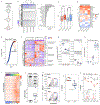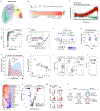Systematic single-cell pathway analysis to characterize early T cell activation
- PMID: 36417885
- PMCID: PMC10704209
- DOI: 10.1016/j.celrep.2022.111697
Systematic single-cell pathway analysis to characterize early T cell activation
Abstract
Pathway analysis is a key analytical stage in the interpretation of omics data, providing a powerful method for detecting alterations in cellular processes. We recently developed a sensitive and distribution-free statistical framework for multisample distribution testing, which we implement here in the open-source R package single-cell pathway analysis (SCPA). We demonstrate the effectiveness of SCPA over commonly used methods, generate a scRNA-seq T cell dataset, and characterize pathway activity over early cellular activation. This reveals regulatory pathways in T cells, including an intrinsic type I interferon system regulating T cell survival and a reliance on arachidonic acid metabolism throughout T cell activation. A systems-level characterization of pathway activity in T cells across multiple tissues also identifies alpha-defensin expression as a hallmark of bone-marrow-derived T cells. Overall, this work provides a widely applicable tool for single-cell pathway analysis and highlights regulatory mechanisms of T cells.
Keywords: CP: Immunology; SCPA; T cell; arachidonic acid; cytokines; gene set; metabolism; pathway analysis; single-cell RNA-seq; single-cell pathway analysis; type I interferon.
Published by Elsevier Inc.
Conflict of interest statement
Declaration of interests The authors declare no competing interests.
Figures





References
Publication types
MeSH terms
Grants and funding
LinkOut - more resources
Full Text Sources
Molecular Biology Databases
Miscellaneous

